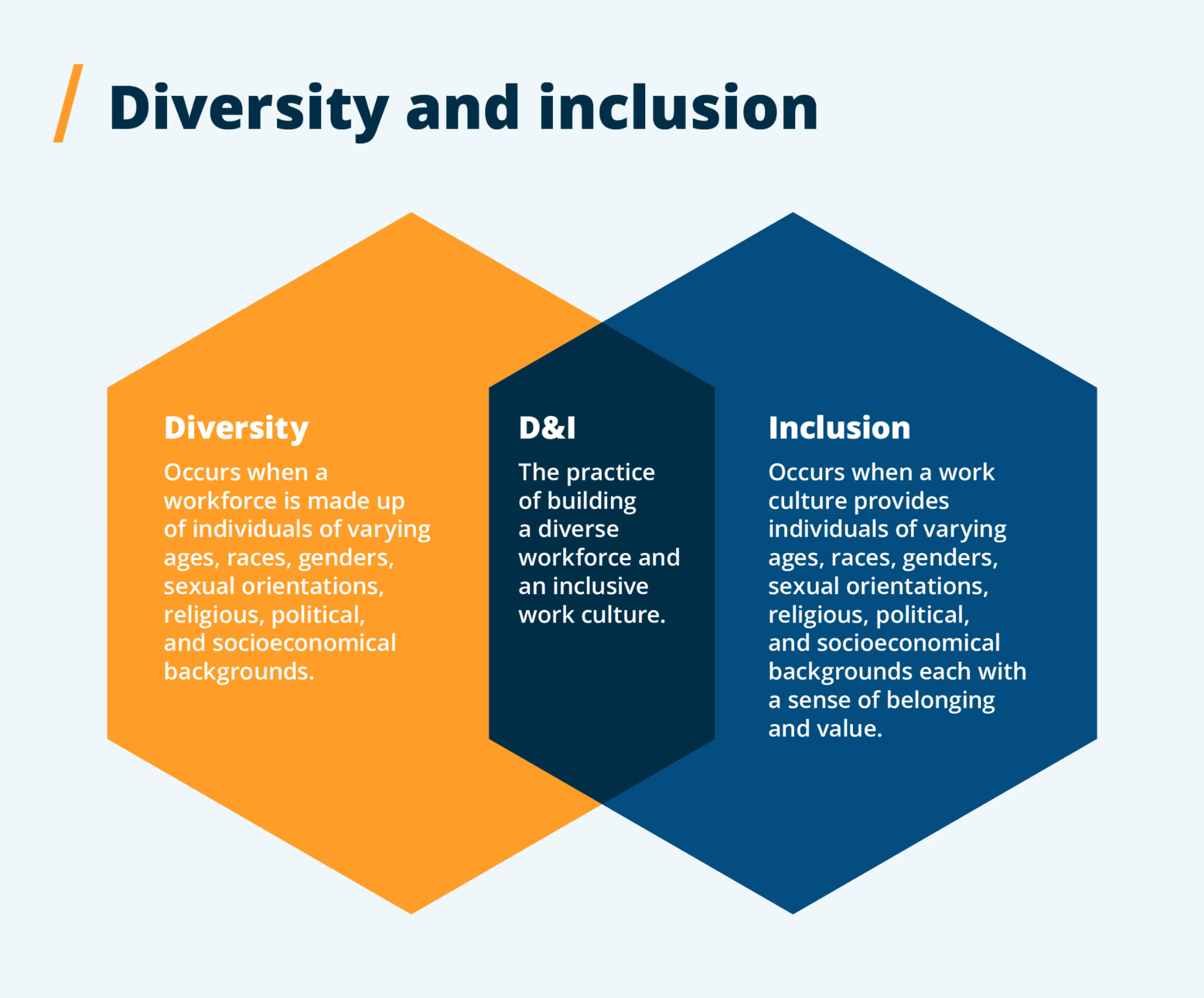D&I is equal parts diversity and inclusion. Understand how they differ.
Both in practice and in conversations about diversity and inclusion (D&I) initiatives, the “inclusion” part of the equation is often overlooked and misunderstood.
Take for example that in 2021, Gartner reported that although 90% of organizations have a diversity and inclusion strategy in place, only a little over a quarter (27%) of employees indicate their organizations inform them of opportunities to promote inclusion in daily work (full content available to Gartner clients).
Failing to incorporate inclusion into your D&I strategy is a common pitfall for HR leaders, and unfortunately—between high turnover and low employee engagement—the consequences are notable.
If you’re an HR leader who’s tasked with creating an effective D&I strategy, you need to understand the difference between diversity and inclusion in order to make sure you’re considering both aspects when developing and rolling out new initiatives.
Ahead, we’ll define the difference between diversity and inclusion, explain the importance of each, and offer tips on how to improve both so that you can ensure your D&I strategy is as effective as possible.

What is diversity and inclusion (D&I)?
Diversity and inclusion refers to the programs, policies, and processes that support diverse groups of people working in an organization. D&I promotes equal representation for people of different races, religions, genders, and sexual orientations. Human resources (HR) is typically responsible for D&I; however, outside companies are sometimes hired to implement D&I training and policies.
In 2021, Gartner reported that a majority (77%) of organizations have had D&I as a corporate priority for more than three years (full content available to clients). In part, this is due to the fact that creating a diverse, inclusive, and equitable working environment contributes to organizational success—more on that later.
Ready to hire a recruiting agency for your business needs? Browse our list of companies in the following areas:
What is diversity?
Diversity is a term used to describe a workforce made up of employees with a wide range of characteristics and experiences, from varying languages and cultural backgrounds to generational and educational differences.
The U.S. Department of Housing and Urban Development describes diversity like this:
“In simple terms, diversity is the mix.”
Businesses that practice diversity employ workers with differing values, cultures, backgrounds, and skills. And although historically, companies have measured workforce diversity in terms of race, ethnicity, or gender identity, the truth is diversity covers a much wider breadth of individual characteristics, including things such as:
Age
Sexual orientation
Religious or political beliefs
Socioeconomic background
Education
Disability
Geographic location
Why is diversity essential for businesses?
Diversity in demographics leads to diversity in thought, which is essential for businesses to succeed. In fact, the numbers speak for themselves: Gartner reports that companies with more diversity have 19% higher innovation revenue and 9% higher earnings before interest and taxes (EBIT) margins (full content available to Gartner clients).
Additionally, today’s job seekers consider diversity a deciding factor when evaluating companies.

As an HR professional, you’re likely aware of the ongoing talent shortage that’s posed a challenge for today’s recruiters. But just to quantify it: Capterra’s Recruiting Strategy Survey* revealed that 56% of employees with recruiting responsibilities fear there are job openings they’ll never be able to fill. In an environment such as this, HR leaders should be doing everything in their power to make their company culture appealing to job seekers, and as is proven by the statistics above, that means embracing diverse talent.
Put simply: Businesses that lack diversity doom themselves to a Sisyphean fate of mediocrity. Without the ability to draw from a wide variety of perspectives and ideas, the same tactics are utilized, the same solutions are proposed for problems, and the same products roll off the assembly line. Not to mention, they’ll also have a harder time attracting quality talent, which isn’t a good spot to be in the midst of today’s talent shortage. So if this is your company, how can you improve your organization’s diversity in an appropriate manner?
How to improve diversity at your organization
Find new sources for job candidates. If your candidate pool draws from the same candidate sources—the same job boards, the same social media groups, the same competitors—how do you expect to ultimately make a diverse hire? Expand your reach by posting vacancies on niche job boards or reach out to promising passive candidates that aren’t actively looking for a new job, but would consider a change.
Mitigate biases in your hiring processes. Removing subjectivity in how you evaluate and hire job candidates allows for more fair comparisons between them. That means standardizing both the questions asked in interviews for a given role (instead of winging it), and the criteria by which candidates are evaluated.
Make hiring decisions a group consensus. One strategy you can use to mitigate the biases of any one person is to make every hiring decision a majority or consensus decision among a group of people. When possible, aim to create a hiring panel made up of a diverse group of employees in terms of age, gender, background, seniority, and position within the relevant department.
Capterra tools and tips
With the tips above fresh in your mind, we want to make a few additional suggestions for how you can leverage technology to put these practices in action.
Post openings to sites that cater to minority job seekers. One way to increase the diversity of applicants your listings are attracting is to diversify where you post them. Jopwell and PowerToFly are just two examples of websites built around connecting minority employees to job opportunities.
Look forrecruiting software that offers blind hiring mode. Blind hiring mode is a feature designed to minimize unconscious biases during the screening process. It works by redacting the personal and demographic information of all applicants. Ask your software vendor if this feature is available with their platform, or consider manually taking steps to redact applicants’ information.
Opt for anapplicant tracking system (ATS) that offers screening assessments. Incorporating skills-based tests into your hiring process allows you to evaluate applicants based on their know-how, instead of what’s on their resume.
What is inclusion?
Inclusion refers to the practice of providing all of the people that make up your workforce (especially those who are disadvantaged for one reason or another) with equal opportunities and treatment. From the perspective of an employee, inclusion is best defined as a sense of belonging that comes from being recognized and valued for the unique perspective and skills you bring to the organization.
Businesses that practice inclusion promote an environment of collaboration, flexibility, and fairness, where every employee’s distinct perspective and talent is effectively utilized.
The U.S. Department of Housing and Urban Development describes inclusion like this:
“In simple terms, inclusion is getting the mix to work together.”
Why is inclusion essential for businesses?
On the surface, diverse businesses that lack inclusion can appear to be humming along soundly. Over time, however, resentment will begin to set in as minority groups are repeatedly discriminated against or stonewalled in their attempts to contribute or advance.
Not only will that resentment contribute to a toxic company culture, but it will eventually lead to higher turnover rates—especially among minority employees. And on top of that, companies that lack inclusion are less likely to attract job seekers in the first place, which, as we discussed in the section on the importance of diversity, is a major concern for recruiters.

To summarize: Employee engagement takes a nosedive when workers perceive a lack of inclusion in their workplace, which will eventually drive your employees to leave your company in search of a more inclusive environment elsewhere.
How to improve inclusion at your organization
Reevaluate your rewards and recognition systems. Are you really rewarding your top performers, or do you just think you are? Consult historical performance data to determine if your organization is promoting those who have earned it. If they’re not, meet with team managers to diagnose reasons why that isn’t happening. You should also leverage technology that allows workers to recognize each other, increasing the likelihood that every employee’s accomplishments are seen by leadership.
Adopt inclusive policies. For parents, it could be improving your parental leave policy. For ethnic minorities, it could be company-wide recognition of holidays that they celebrate. For those with disabilities, it could mean greater accessibility options in your office. There are a thousand things you can do to be more inclusive, but it means nothing if you only talk about them.
Support the formation of employee resource groups (ERGs). Inclusion dies in silence, which is why you should encourage employees to form ERGs that support those who have a muted or nonexistent voice in the company. The goal of these groups is three-fold: 1) Education on the common obstacles against this group, 2) training on how to be more inclusive of this group, and 3) consolidation and support for ideas that drive equality. HR professionals should also encourage leaders to attend ERG events in order to increase the groups’ reach across your organization.
Bottom line: Diversity doesn’t stick without inclusion.
Mentions of diversity, equity, and inclusion (DEI) on S&P 500 earnings calls have increased 658% since 2018. But in May of 2022, Gartner released a report that stated that in a survey of 3,500 employees from around the world, only 18% believe they work in a high-fairness environment.
Clearly, the majority of organizations care about creating a diverse and inclusive workforce—but what’s just as evident is that they’re not getting it right just yet.
For diversity efforts to succeed for your organization, you have to devote equal attention to inclusion, and that starts with a better understanding of the basics. To recap:
Term | Definition | Who’s responsible |
|---|---|---|
Diversity | Diversity is the term used to describe when a workforce is made up of individuals of varying ages, races, genders, sexual orientations, religious, political, and socioeconomical backgrounds. | The human resources department; specifically, those involved in the recruiting and hiring process. |
Inclusion | Inclusion occurs when a work culture provides individuals of varying ages, races, genders, sexual orientations, religious, political, and socioeconomical backgrounds each with a sense of belonging and value. | Everyone from individual contributors to team managers, but executives have a responsibility to set an example for the company culture. |
Diversity and inclusion (D&I) | D&I refers to the programs, policies, and processes within an organization that support diverse groups of people working together. It promotes equal representation for people of different races, religions, genders, and sexual orientations. | D&I planning is headed by the HR department, but team managers must help out by sharing resources with their reports. |
As a next step, start thinking about how your business can devote equal resources and attention toward diversity and inclusion efforts. Whether that means upgrading or investing in new software in order to remove bias from your recruiting process or revisiting policies related to parental leave and holidays, there’s always more that can be done.
For more content like this, check out The Future of Talent Management is Diversity Tech, Continuous Learning, and Prioritizing Mental Health.

